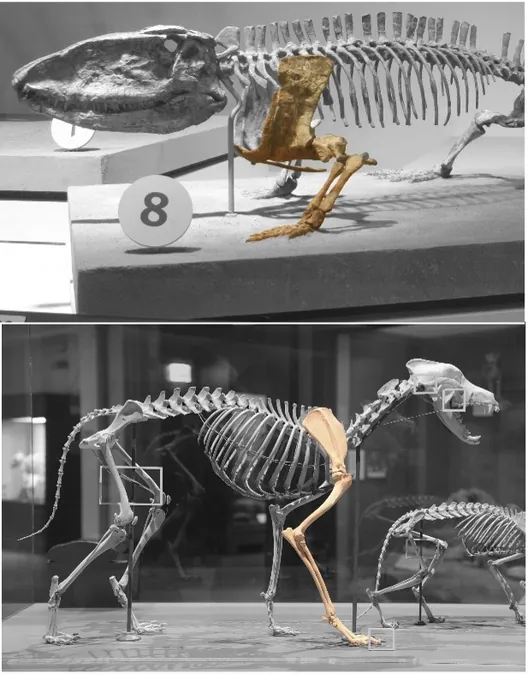
Mammals on the Move: The Surprising Evolution to Upright Posture
2025-06-24
Author: John Tan
Unlocking the Mystery of Mammal Evolution
For over a century, scientists have grappled with a pivotal question in evolutionary biology: How did mammals evolve from a sprawling stance akin to lizards to the upright posture we see in cats, dogs, and even humans? This transition not only signifies a major milestone in mammal evolution but also raises intriguing questions about our origins.
A Groundbreaking Study Reveals Unexpected Paths
A new study published in PLOS Biology, spearheaded by Robert Brocklehurst of Harvard University, provides revelatory insight into this evolutionary journey. Interestingly, the switch to an upright posture was anything but straightforward. It was riddled with surprising changes, evolutionary experimentation, and dramatic shifts in anatomy.
All mammals, from whimsical bats to colossal whales, share a unique limb structure that enables them to move efficiently. This anatomical adaptation is crucial for various lifestyles, including digging and flying. Notably, this shift came with significant alterations in the shape and mechanics of limb bones.
Digging Deep Into Fossil Anatomy
To uncover the evolution of mammalian posture, the research team meticulously analyzed the humerus—the upper arm bone—of over 60 non-mammalian synapsid fossils and 140 living species, spanning millions of years. This study combined fossils from different evolutionary stages, including mammals, reptiles, and amphibians.
Utilizing pioneering digital mapping technology developed in Professor Stephanie Pierce’s lab, the researchers examined each bone's length, mass distribution, muscle leverage, and torsion, which are instrumental in understanding various locomotion patterns. This innovative method enabled them to reconstruct ancient postures and movements.
A Landscape of Functional Adaptations
The researchers created a functional adaptive landscape, akin to a topographic map, illustrating high and low performance related to different movement styles. Brocklehurst shared his surprise: "We anticipated a smooth progression from sprawling ancestors to upright mammals, but instead, we discovered bursts of evolutionary innovation."
The Evolutionary Tale: Not as Straightforward as Thought
The findings propose that mammal evolution was characterized by several adaptive radiations, where various ancestral groups explored diverse forelimb functions and postures. Rather than a direct ascent leading to modern mammals, the evolutionary journey showcases an intricate web of adaptations to various environments.
Notably, one fossil closely related to marsupials exhibited bone structures aligned with modern upright movement, suggesting that fully vertical limb postures evolved later than previously believed. This aligns with recent studies from the same research group focusing on advancements in backbone and hind limb evolution.
A Revolutionary Perspective on Early Mammals
These discoveries challenge long-held views about gradual posture changes in early mammals. "Our research indicates that the shift to upright posture was a relatively late occurrence, not an early defining characteristic of mammals," said Pierce.
Furthermore, the study refutes the notion that early synapsids moved in the same way as contemporary reptiles. Co-author Kenneth Angielczyk from Chicago's Field Museum emphasized, "Our findings reveal that most synapsid limbs operated differently from modern reptiles, showcasing unique adaptations absent in today's wildlife."
Advancing Fossil Analysis with Cutting-Edge Technology
To analyze such diverse fossils effectively, the team innovated existing software tools into a new "slice-based" landmarking technique, specifically tailored for their extensive dataset. Co-author Magdalen Mercado played a pivotal role in this research during her senior thesis.
Pierce highlighted that even renowned paleontologists, like Alfred Sherwood Romer and Farish Jenkins, faced these questions over a century ago. "This study marks the first large-scale evolutionary analysis of mammalian posture through quantitative biomechanics. With state-of-the-art tools and fresh data, we can illuminate past scientific inquiries more clearly than ever."
Funding and Future Directions
This groundbreaking research received partial funding from the National Science Foundation, setting the stage for further exploration into the evolution of mammalian movement and posture.


 Brasil (PT)
Brasil (PT)
 Canada (EN)
Canada (EN)
 Chile (ES)
Chile (ES)
 Česko (CS)
Česko (CS)
 대한민국 (KO)
대한민국 (KO)
 España (ES)
España (ES)
 France (FR)
France (FR)
 Hong Kong (EN)
Hong Kong (EN)
 Italia (IT)
Italia (IT)
 日本 (JA)
日本 (JA)
 Magyarország (HU)
Magyarország (HU)
 Norge (NO)
Norge (NO)
 Polska (PL)
Polska (PL)
 Schweiz (DE)
Schweiz (DE)
 Singapore (EN)
Singapore (EN)
 Sverige (SV)
Sverige (SV)
 Suomi (FI)
Suomi (FI)
 Türkiye (TR)
Türkiye (TR)
 الإمارات العربية المتحدة (AR)
الإمارات العربية المتحدة (AR)